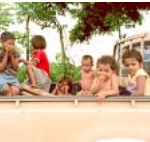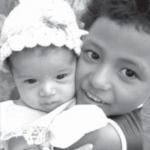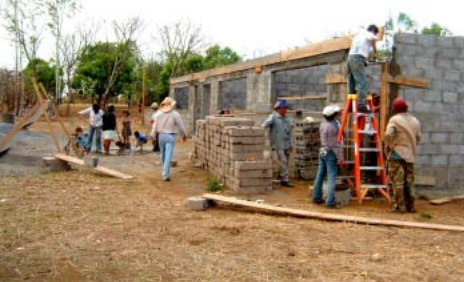
Newsletter – Vol. 1 – Spring 2005
Extra! Extra! – Chacocente Celebrates its 2nd Birthday
Project Chacocente celebrated its second birthday (Jan. 23) with several pieces of good news! Perhaps the most welcomed is that we are now a 501“(c)3” organization, meaning that all donations are now tax-deductible.
The most exciting news is that we have begun construction on the school/church complex. Read more about that on this page. And finally, we have negotiated with the government to bring into our project the family whose three sons were killed Dec. 8 when they ate pesticide-covered peanuts they found in the dump. There had been rumors that the government planned to take away the Orozco family’s remaining four children.
We are sending you this newsletter because so many people have asked to be kept up to date on Project Chacocente. We hope you find it interesting and thought provoking.
School Bells and Masons’ Trowels Rrring!
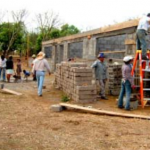 It’s a school! It’s a church! It’s a training center!! Thanks to you, we have begun construction of the first half of Chacocente’s school. The classrooms are part of a larger building that will also serve as our church(es) and training/ development center. (Each room will have at least two purposes: the preschool is also our child- development room; the 3rd grade is also our hammock workshop.) We expect to finish the first three classrooms by the end of March.
It’s a school! It’s a church! It’s a training center!! Thanks to you, we have begun construction of the first half of Chacocente’s school. The classrooms are part of a larger building that will also serve as our church(es) and training/ development center. (Each room will have at least two purposes: the preschool is also our child- development room; the 3rd grade is also our hammock workshop.) We expect to finish the first three classrooms by the end of March.
School began Feb. 14 in make- shift rooms lovingly put together by the students’ parents. There are no lights, and no books (yet!), but the children are excited to be studying with their own teachers, in small classes which allow one-on-one assistance. (In the state schools, where each teacher has a minimum of 40 students, if you don’t understand the lesson, you often have to pay the teacher for after- school tutoring. Since most children don’t have the money, they don’t get the help they need; and therefore enter a frustrating spiral of understanding less and less each day.)
We were blessed this quarter by the assistance of several delegations and volunteers as we dug the foundation, installed the seismic columns, and finally began laying cinderblocks. (You can find a list of those delegations on page 3, along with information of how you or your church/school/group can become a workteam at Chacocente.)
Digging Deeper: Thoughts from the Haze
by Cheryl Avery, Executive Director
When we began Project Chacocente in January 2003, one of the first things we did was speak with Ernesto Cardenal, who has served God and Nicaragua as a priest, Minister of Culture, poet, historian and prolific writer. Now in his 80s, slight of stature, and his signature beret always atop his full head of white tousled hair, he con- tinues to quietly turn out books about his beloved Nicaragua. But Father Cardenal is perhaps best known for his work in the ‘60s with the people of Solentiname Island in Lake Nicaragua.

Two important developments – one cultural, the other spiritual – were born of that work. Characteristically, Fr. Cardenal denies he had much to do with either. A new, painstakingly detailed style of painting was created, where trees took on purple, pink or blue hues in a sea of Nature’s green, while people were depicted as primitive doll-like impressions of life. The style remains as one of the most significant expressions of Nica- raguan culture, fetching first-world fees for the best artists. (Of his influence on this movement, Fr. Cardenal only says: “They wanted to paint; I bought them paints and cloth.” )
Also during that time, a series of New Testament interpretations were published as The Gospel According to Solentiname, notable because they were “authored” by the humble residents of the island itself in Bible discussions at Fr. Cardenal’s house. As these undereducated peasants began to express themselves in literature and in art, it seemed the whole world was watching. And eventually, amid the political unrest of the time, dictator Anastasio “Tacho” Somosa had the island bombed and the artist commu- nity destroyed.
We approached Fr. Cardenal to discuss how to bring about major transformation in humble people. We knew from experience that community development almost always fails if there is not a distinct transformation – permanent change – in the people. He deflected our pointed questions for a half hour, claiming he knew very little about the subject. And then, as we prepared to go, Fr. Cardenal made one point: “If you are going to transform people, you must use the Gospel.”
It didn’t seem particularly profound at first; we had always planned on incorporat- ing the teachings of Jesus into the project. Then it hit us! He didn’t mean as “a part” of the program, but as the entire basis of the program!!
Over the next few months, I’ll share some of the highlights of the progress that our families have made. They are impressive. But I can tell you this now: Not one mile- stone has been reached where love was not expressed, and shared, first. As it turns out, the best process for achieving modern community development can be found in one of the oldest books available: The Bible.
Delegations Come in Solidarity and Love
The first few months of 2005 have been joyful ones, as delegations from various churches and organizations around the U.S. have come to help us build not only school rooms, but relationships!! Among them:
- A workteam led by David and Marie Fincher from Cedartown, Georgia, comprised mostly of members of the Fellowship of Vineyard Harvester Church. They were fortified by the youthful exuberance of Chacocente volunteers Nathan Reitz (Colorado) and Adam LoPresti (Montana). Ask them about digging a foundation in dust and wind!
- The second group was led by Dan James and Dick McNally of Lexington, Kentucky, and primarily comprised of members of the Bountiful Grace Corporation. Child care was provided by volunteers Susan Francis, Jessica Uze, and Emily and Laura Dodd, all of Oberlin College. They tied rebar and sifted sand, laid block and asked questions!
- Hurlbut UMC (Chautauqua, NY), led by pastor Ted Anderson, spent days in the scorching sun doing construction; then took the entire community to Pochomil Beach for a little fun. Ted & church were joined by Paul Stephenson of Ohio.
- Lexington UMC (MA), led by pastor Susan Morrison, visited us as part of an annual trip to work at their sister church in La Borgoña.
Forgive us: Lack of space prevents listing all your wonderful names!!
Orozco-Cruz Family Makes Their Home at Chacocente
Invited in 2004 to move to Chacocente, the Orozco-Cruz family wanted only to stay in the dump a few months more so their five school-aged children would not lose the year. It was the request of parents just wanting the best for their children.
However, in December, just a week after school let out for the year, three of the Orozco-Cruz children left the house in search of discarded Purisima treats. (Purisima is the week- long celebration by the Catholic church of the Virgin Mary.) The older boy found some peanuts, and joyfully shared them with his brothers. Within the hour, the three boys were dead. The peanuts had been treated with toxic pesticide.
The deaths were recorded in the local media for three consecutive days, and the government – perhaps trying to deflect criticism that families must live at the dump — threatened to take away the Orozco’s four remaining children. Pedro and Basilia, the parents, took their children and went into hiding…from the government, and from us.
In January, we were able to locate the Orozcos, and took them to the government ministry where we negotiated a new life for the family at Chacocente. They are now among us, three of the children in school; baby David, formerly just skin and bones, gaining a little weight and losing the death-stare that so many malnourished babies acquire.
The family has a lot of adjusting to do: Pedro and Basilia are two full years behind the Chacocente adults in terms of personal and community development. The older children are making new friends, learning how to sit still in class and generally acclimating to a home without garbage, smoke, danger and violence. Believe it or not, it’s not easy. Please keep this family in your prayers; they have a strong faith, and your prayers will help.
Our History is Short, but Productive!
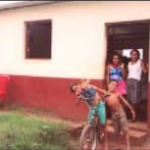
Project Chacocente started January 23, 2003. We selected 10 families from the dump and built a staff over the next few months. Construction of the first house began in July 2003.
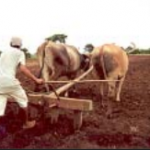
Nicaragua growing seasons, beginning in May and in late July. The families have received technical training from NGO World Vision and experienced farmers. We also pray before we plant! Our first three harvests of corn and beans have been great successes!
Download The Original Printed Version Here: Vol. 1 – Spring 2005


